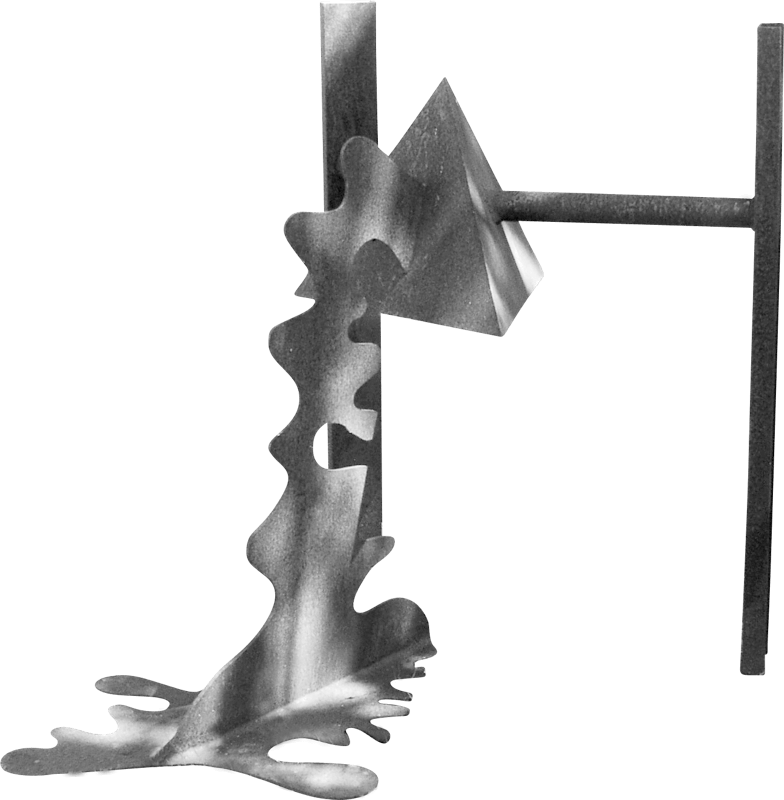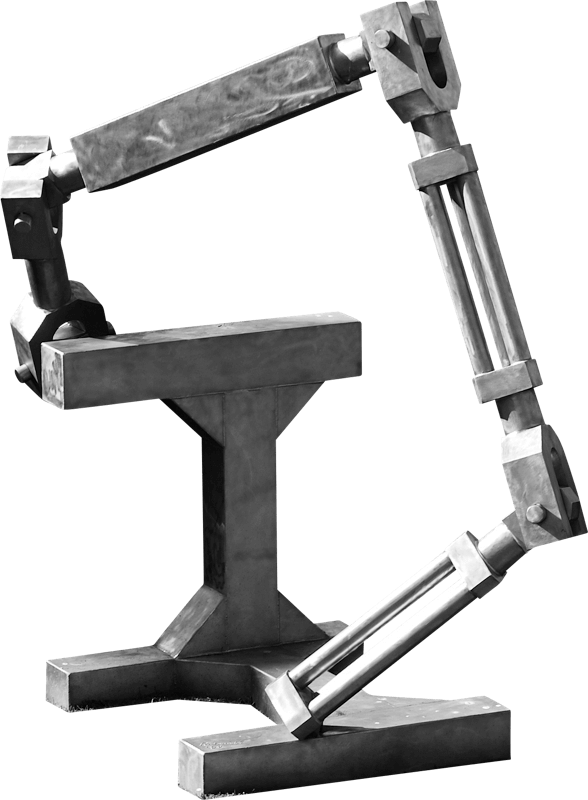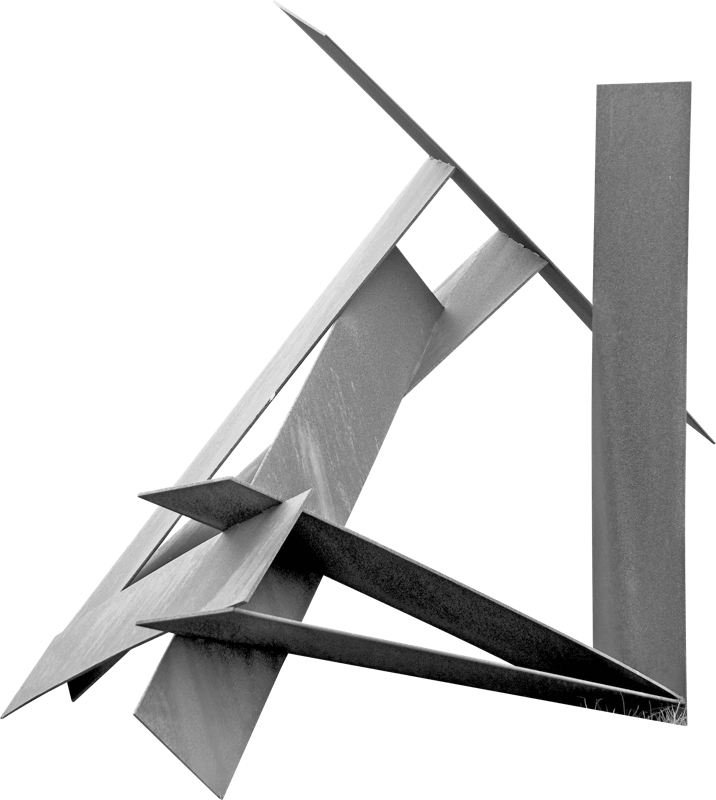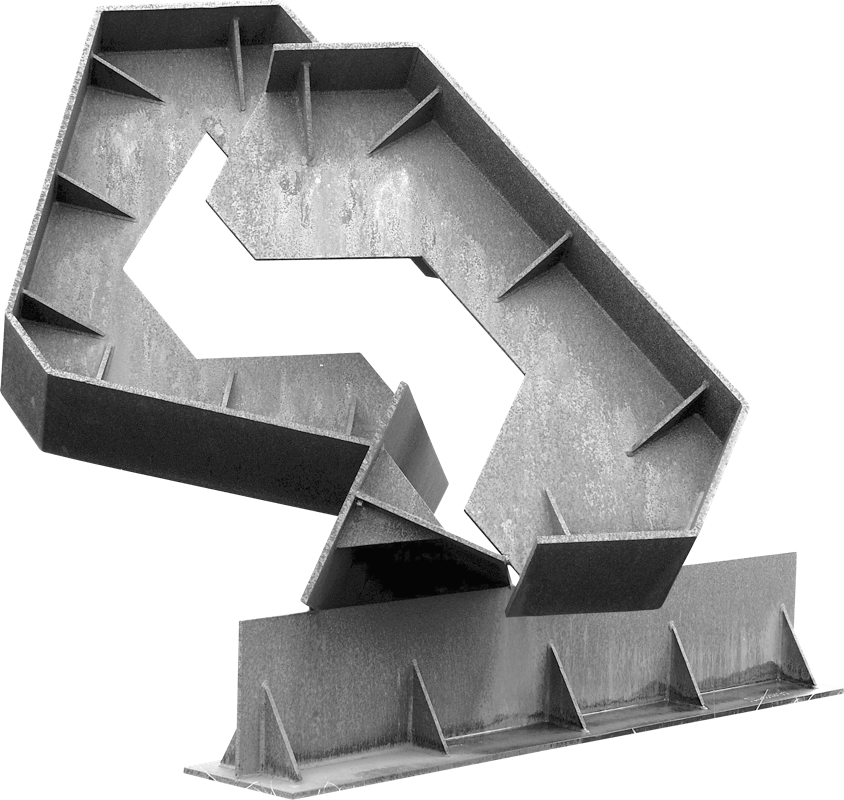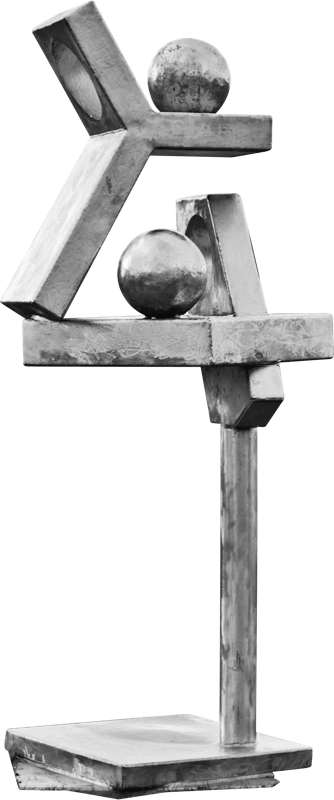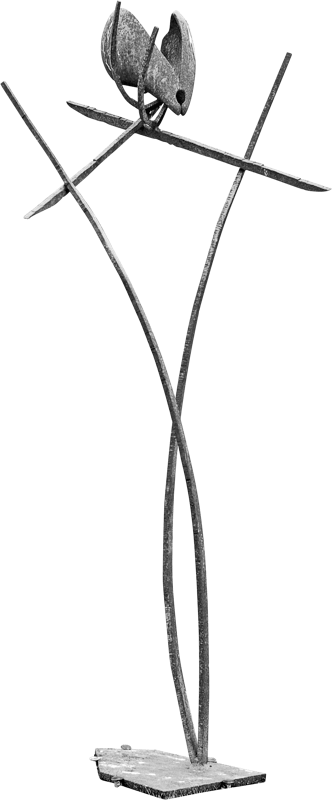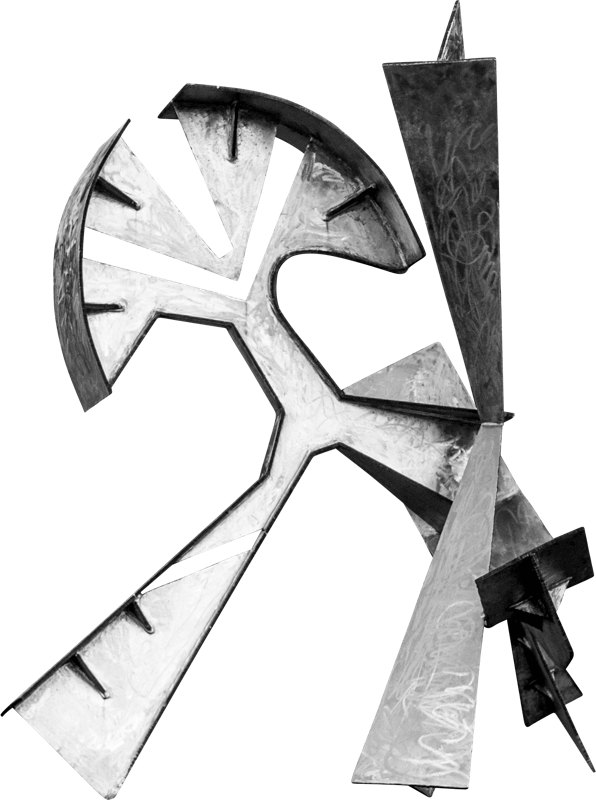Series 4
The sculptures of Series 4 were Rubinoff’s most complex to date. These sixteen works are not constructed from simple straight planes like their predecessors, but from a dense arrangement of T-sections, triangular brackets, curves and double-curves, geometrical patterns and articulated negative spaces. They allude not to the purity and effervescence of line but to the teeth and cogs of machines. These powerful and accomplished artworks were critically acclaimed, and widely exhibited, at the time. They were shown at the Marlborough Gallery in New York, the Nathan Manilow Sculpture Park in Chicago, and at Queen’s Park and York University in Toronto.
Series 4-1
Jeffrey Rubinoff
1983, A 242 Cor-ten steel – Welded plate, H 7ft W 8ft L 8ft
Evolving directly out of the final piece of Series 3, this first work in Series 4 also sets up straight T-section components in counterpoint to each other. The small triangular forms are actually welding supports, or gussets, which in the previous series had been removed. In Series 4, however, they become a crucial aesthetic innovation. In addition to generating polyrhythms, the gusset plates create a visual arrowhead direction within each T-section, breaking up the forms in highly complex ways.
Evolving directly out of the final piece of Series 3, this first work in Series 4 also sets up straight T-section components in counterpoint to each other. The small triangular forms are actually welding supports, or gussets, which in the previous series had been removed. In Series 4, however, they become a crucial aesthetic innovation. In addition to generating polyrhythms, the gusset plates create a visual arrowhead direction within each T-section, breaking up the forms in highly complex ways.
Series 4-2
Jeffrey Rubinoff
1983, A 242 Cor-ten steel – Welded plate, H 7ft W 8ft L 7ft
Series 4-2
Jeffrey Rubinoff
1983, A 242 Cor-ten steel – Welded plate, H 7ft W 8ft L 7ft
Rubinoff referred to this work as his “Turbine Piece.” Its main aesthetic innovation is the introduction of angled turns in the vector of the planes as they move through space. Until this piece, all of Rubinoff’s forms were built from straight lines. These geometrical undulations create an aperture at the centre of the work, masterfully shaped to echo the positive forms of the T-sections, that expands and contracts like an iris as the viewer circumambulates it. This highly accomplished sculpture was exhibited at the Marlborough Gallery in New York in 1984, and featured in the April 1984 edition of Art in America.
Series 4-3
Jeffrey Rubinoff
1983, A 242 Cor-ten steel – Welded plate, H 7.5ft W 8ft L 8ft
Series 4-4
Series 4-4
Jeffrey Rubinoff
1984, A 242 Cor-ten steel – Welded plate, H 7.5ft W 8ft L 7.5ft
Series 4-4
Jeffrey Rubinoff
1984, A 242 Cor-ten steel – Welded plate, H 7.5ft W 8ft L 7.5ft
The fourth work in the series is composed of three gussetted T-sections piled atop each other in ever more vertical trajectories, not unlike the method used in Series 3-1. They are joined by a highly complex fourth form, which employs the folding motif introduced in Series 4:3. Rubinoff here also experiments with a thin cut-away, which creates a graphic line through the middle of the COR-TEN plate, animated by its changing backgrounds. This sculpture was exhibited at the Marlborough Gallery in New York in 1984, and featured in the April 1984 edition of Art in America.
Series 4-5
Jeffrey Rubinoff
1984, A 242 Cor-ten steel – Welded plate, H 6.5ft W 9ft L 8ft
This sculpture introduces, for the first time in the series, a curvilinear motif that rises from the T-sections below. Rubinoff fabricated the form by himself, bending many thinner sheets of steel together with a winch, then laminating them together. The juxtaposition of angular and curved shapes generates considerable visual drama, particularly at the points at which the circular shape collides with its base, cracking apart to create a cluster of negative spaces.
This sculpture introduces, for the first time in the series, a curvilinear motif that rises from the T-sections below. Rubinoff fabricated the form by himself, bending many thinner sheets of steel together with a winch, then laminating them together. The juxtaposition of angular and curved shapes generates considerable visual drama, particularly at the points at which the circular shape collides with its base, cracking apart to create a cluster of negative spaces.
Series 4-6
Jeffrey Rubinoff
1984, A 242 Cor-ten steel – Welded plate, H 8ft W 8ft L 8ft
Series 4-6
Jeffrey Rubinoff
1984, A 242 Cor-ten steel – Welded plate, H 8ft W 8ft L 8ft
In this sculpture Rubinoff retains the circular motif introduced in 4-5, but deconstructs it further. The upper ‘crack’ has grown wider, another fissure runs across the full width of the disc, and at one side the curve becomes angular again. Another major innovation here, and one that motivated so much of Rubinoff’s work, is the emphasis on ascension. Unlike in its predecessor, Rubinoff elevates the main circular form high above the Cor-ten nest beneath it, almost as if a figure is holding it aloft to the skies.
Series 4-7
Jeffrey Rubinoff
1984, A 242 Cor-ten steel – Welded plate, H 9ft W 9ft L 9ft
This sculpture extends the bottom of the disc into two leg-like forms, one of which continues to the ground and provides one of the principal supports of the composition. The piece also contains three prominent negative spaces: two of them are arrow-like forms that face each other along the horizontal axis; the third cuts down from the apex of the sculpture, colliding with a similar positive form near the centre of the circle. Together these two visual confrontations create a dynamic visual vortex at the centre of the piece.
This sculpture extends the bottom of the disc into two leg-like forms, one of which continues to the ground and provides one of the principal supports of the composition. The piece also contains three prominent negative spaces: two of them are arrow-like forms that face each other along the horizontal axis; the third cuts down from the apex of the sculpture, colliding with a similar positive form near the centre of the circle. Together these two visual confrontations create a dynamic visual vortex at the centre of the piece.
Series 4-8
Jeffrey Rubinoff
1985, A 242 Cor-ten steel – Welded plate, H 9ft W 9ft L 9ft
Series 4-8
Jeffrey Rubinoff
1985, A 242 Cor-ten steel – Welded plate, H 9ft W 9ft L 9ft
Rubinoff’s eighth sculpture in the series makes yet another remarkable innovation: it retains the curved motif, but constructs it entirely from negative space. The crown form, first developed in 4-5, has become a boxy triangle, with a semi-circle carved out of its centre. That curve is echoed by another semi-circle in the plate behind it. The distance between them produces a masterfully articulated curve of empty space, perpendicular to the two plates, which changes shape as the viewer moves around it.
Series 4-9
Jeffrey Rubinoff
1985, A 242 Cor-ten steel – Welded plate, H 9ft W 10ft L 9ft
Nine feet high and ten feet wide, this is the largest sculpture in Series 4. It also features a number of original motifs. It recycles the cut-back T-section first used in 4-4, but rotates it upwards, and lays it flat along the ground. It also fuses the triangular gussets that are such a signature of this series with the T-section contours, adding a further level of surface complexity to an already complex work.
Nine feet high and ten feet wide, this is the largest sculpture in Series 4. It also features a number of original motifs. It recycles the cut-back T-section first used in 4-4, but rotates it upwards, and lays it flat along the ground. It also fuses the triangular gussets that are such a signature of this series with the T-section contours, adding a further level of surface complexity to an already complex work.
Series 4-10
Jeffrey Rubinoff
1985, A 242 Cor-ten steel – Welded plate, H 9.5ft W 8ft L 8ft
Series 4-10
Jeffrey Rubinoff
1985, A 242 Cor-ten steel – Welded plate, H 9.5ft W 8ft L 8ft
This, the tenth sculpture in the series, is the most vertically oriented of all. Despite their massive weight and volume, Rubinoff’s steel forms rise more than nine feet into the air in two powerful thrusts — one forward, the other backward. Rubinoff begins using thicker plate for the gussets, but continues the motif from 4-9 of blending them into the T-sections themselves. This creates a sense of two prominent arteries flowing up to the apex of the piece.
Series 4-11
Jeffrey Rubinoff
1985, A 242 Cor-ten steel – Welded plate, H 8.5ft W 8ft L 8ft
Up to this point in the series, Rubinoff crowned his sculptures either with a truncated triangle (4-3, 4-8) or a fragmented semi-circle (4-5, 4-6, 4-7, 4-9, 4-10). In this remarkable piece, he uses both. The result is a unique double-headed composition. Each of the heads contains both curved and angular components, creating an intricate counterpoint between the two. Rubinoff innovates further by penetrating the triangular head with one of the base T-sections.
Up to this point in the series, Rubinoff crowned his sculptures either with a truncated triangle (4-3, 4-8) or a fragmented semi-circle (4-5, 4-6, 4-7, 4-9, 4-10). In this remarkable piece, he uses both. The result is a unique double-headed composition. Each of the heads contains both curved and angular components, creating an intricate counterpoint between the two. Rubinoff innovates further by penetrating the triangular head with one of the base T-sections.
Series 4-12
Jeffrey Rubinoff
1986, A 242 Cor-ten steel – Welded plate, H 6.5ft W 8ft L 8ft
Series 4-12
Jeffrey Rubinoff
1986, A 242 Cor-ten steel – Welded plate, H 6.5ft W 8ft L 8ft
After the large scale of its predecessors, Rubinoff here returns to a more reduced volume. The sculpture, however, is no less complex than the others. Rubinoff retains the dual circle-triangle motif introduced in 4-11, but flips the triangle upside down, and delineates it in negative rather than positive space. Meanwhile, his choice of thick, 1-inch, plate gives the work a dense, almost architectural texture.
Series 4-13
Jeffrey Rubinoff
1986, A 242 Cor-ten steel – Welded plate, H 7ft W 8ft L 8ft
The thirteenth sculpture in the series contains perhaps the most striking innovation of them all. In the middle of the semi-circular crown, which now stretches into an ellipse, Rubinoff carved an elegantly undulating aperture that is often compared to a vagina. It is not the only curve in the sculpture: one of the T-section bars, hitherto only straight, now curves upwards to the sky, echoing the contours above it.
The thirteenth sculpture in the series contains perhaps the most striking innovation of them all. In the middle of the semi-circular crown, which now stretches into an ellipse, Rubinoff carved an elegantly undulating aperture that is often compared to a vagina. It is not the only curve in the sculpture: one of the T-section bars, hitherto only straight, now curves upwards to the sky, echoing the contours above it.
Series 4-14
Jeffrey Rubinoff
1986, A 242 Cor-ten steel – Welded plate, H 5.5ft W 7.5ft L 5ft
Series 4-14
Jeffrey Rubinoff
1986, A 242 Cor-ten steel – Welded plate, H 5.5ft W 7.5ft L 5ft
By this late stage in the series, Rubinoff has reduced his scale dramatically. At five feet high and five feet long, this piece is almost half the size of the largest in the group. The circular crown is penetrated by three slices — two angular, one curved — but perhaps the most distinctive feature is a long T-section which rises diagonally across the whole length of the sculpture, its support carved into one long shallow curve.
Series 4-15
Jeffrey Rubinoff
1986, A 242 Cor-ten steel – Welded plate, H 7ft W 5ft L 4.5ft
This sculpture bears some resemblance to its immediate predecessor, both in size and in the starburst formation supporting the circular crown. Here, however, it is the T-section bar rather than the crown, that occupies the apex of work, lending the composition a spiky instability that marks it out from its counterparts. Rubinoff also cuts into the crown in four places, with a chevron pattern zigzagging across its full width.
This sculpture bears some resemblance to its immediate predecessor, both in size and in the starburst formation supporting the circular crown. Here, however, it is the T-section bar rather than the crown, that occupies the apex of work, lending the composition a spiky instability that marks it out from its counterparts. Rubinoff also cuts into the crown in four places, with a chevron pattern zigzagging across its full width.
Series 4-16
Jeffrey Rubinoff
1986, A 242 Cor-ten steel – Welded plate, H 8ft W 8ft L 8ft
Series 4-16
Jeffrey Rubinoff
1986, A 242 Cor-ten steel – Welded plate, H 8ft W 8ft L 8ft
After fifteen of his most complex, ambitious and successful sculptures to date, Rubinoff concludes his fourth series with this exuberant work. Noticeably less dense than its predecessors, negative space here plays a particularly dominant role. As a result, the main forms seem to separate before re-connecting, like two dancers with interlocking limbs.












































